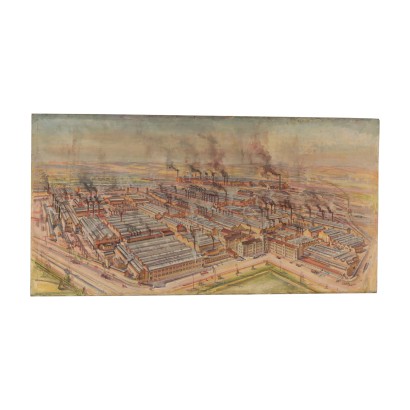Francesco Arata - The urban landscape,1948
Features
The urban landscape,1948
Artist: Francesco Arata (1890-1956)
Artwork title: Paesaggio urbano
Age: 20th Century / 1901 - 2000
Subject: Landscape with Architecture
Artistic technique: Painting
Technical specification: Oil on Canvas
Description : Paesaggio urbano
Oil on canvas. Signed and dated in roman numerals (XXXXVIII) in the lower right. The cremona-born, Francesco Arata was active in Milan, the city where he studied and made his debut in Venice and Burano, where he worked in the 30 years, and in Castelleone, his hometown, where he returned in 1934. Painter, excellent, drew in their own way, and the original current of twentieth-century and, in particular, to Carrà, from which recepì attention to represent Nature in an almost mystical, magical and spiritual; distinguished himself in the production of still-lifes, nudes, portraits and, above all, of countless landscapes, clear, colorful, and clear, portraying glimpses of the mountain lombard or ligurian beaches or the birthplace of Castelleone, or the beautiful city of Venice. The work presented here proposes a different theme and the unusual in the production of Arata: a large industrial agglomeration, the painting of the imagination, even if very close to the image historical of the establishment Falck “Union”, Sesto san Giovanni, note the steel mill to the lombard. The industrial complex seems almost to have a life of their own, as a gigantic engine of production, to the service of humanity. Around the industrial area runs a road with sparse machines; the colors are bright, the stretch of the composition is fast, and calm at the same time; you can see small human figures, who walk, quietly, in what is not perceived as a place excessive or dangerous, but as a hub of vigorous productivity vital. In the background, through the smoke, you see distinctly the landscape, also designed with light colours and serene, almost in the outline of a quiet Nature, and not at all concerned of the actions of the man. The dating in the immediate post-war period, puts the work to symbol optimistic and rebuild a life that is productive and serene. Work not ritelata, in fair condition.
Product Condition:
Product in good condition, has small signs of wear and tear.
Artwork dimensions (cm):
Height: 82
Width: 160
Depth: 2
























